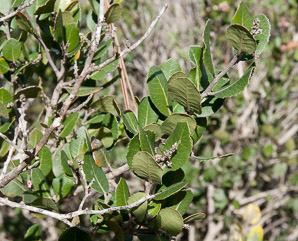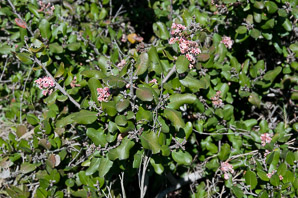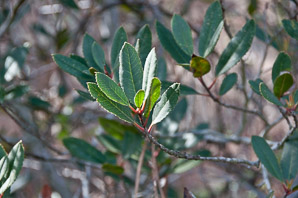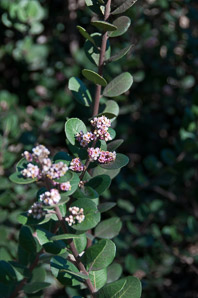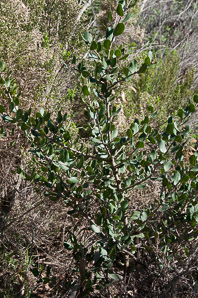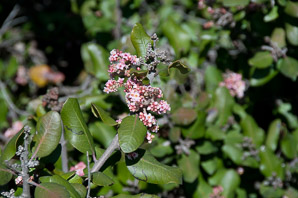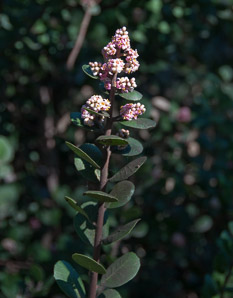
|
Rhus integrifolia (Nutt.) W.H. Brewer & S. Watson Lemonadeberry, lemonade berry, lemonade sumac
Lemonadeberry is native to southern California and the northern part of the Baja peninsula. It prefers well-drained chaparral, below elevations of 2953′ (900 m). Plants: A shrub or small tree 3-26′ (1-8 m) tall, with a sprawling habit. Inland, they often become trees, but closer to the coast, they often remain low, spreading sideways up to 30′ (9.1 m), forming impenetrable thickets. Leaves: Simple, evergeen, leathery, finely toothed, 1¾-2½″ (5-7 cm) × ¾-1½″ (2-4 cm). Leaves have a waxy shine above, and are more pale below. They remind me a little of holly leaves. Flowers: Dense clusters of small, sticky, white to pink flowers. They appear from February to May. Fruits: Berries are dark red and sticky, up to ⅜″ (1 cm) in diameter, and oddly misshapen. Edibility: Fruits are edible raw or cooked, exuding a sour, lemony flavor. Berry clusters are soaked for 10-30 minutes in hot or cold water to make a drink reminiscent of lemonade. Boiling ruins the flavor, releasing excessive tannins. Online References:
The Lady Bird Johnson Wildflower Center Plants for a Future, a resource and information centre for edible and otherwise useful plants 2/26/2010 · Torrey Pines State Park, La Jolla, California · ≈ 3½ × 2′ (103 × 69 cm) 2/26/2010 · Torrey Pines State Park, La Jolla, California · ≈ 12 × 8″ (29 × 19 cm) 2/24/2010 · Batiquitos Lagoon, Carlsbad, California · ≈ 1½ × 1′ (54 × 36 cm)
Rhus integrifolia description by Thomas H. Kent, last updated 13 Sep 2021. © FloraFinder.org. All rights reserved. |
2/26/2010 · Torrey Pines State Park, La Jolla, California · ≈ 9 × 6″ (23 × 15 cm) 2/24/2010 · Batiquitos Lagoon, Carlsbad, California · ≈ 8 × 12″ (21 × 31 cm) 2/24/2010 · Batiquitos Lagoon, Carlsbad, California 2/24/2010 · Batiquitos Lagoon, Carlsbad, California · ≈ 8 × 5″ (19 × 13 cm) 2/24/2010 · Batiquitos Lagoon, Carlsbad, California · ≈ 8 × 12″ (21 × 31 cm) Range:
|


